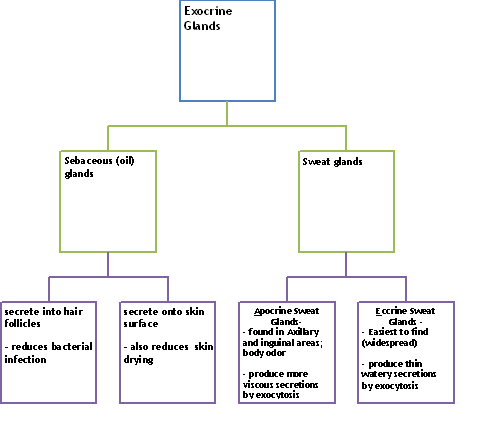Accessory Organs
Sensory Receptors
The skin has several sensory receptors for touch, temperature, stretch and pain, most of which originate in the dermis (Merkel's discs are in the epidermis only). On lab models, you may see free nerve endings (touch, pain, temperature sensations), corpuscles which include Meissner's corpuscles (light pressure) and Pacinian (or lamellated) corpuscles (vibrations and deep pressure, which you could remember by thinking of the "deep Pacific ocean ").
Glands
The skin also has glands, including sweat glands, oil (sebaceous) glands, and ceruminous glands in the ear (therefore, ear wax comes from modified sweat glands). Sweat glands (also called sudoriferous glands) are a type of exocrine gland, because their secretions go through a duct to the outside of the body somehow (in this case through a sweat duct to a sweat pore on the surface). There are two kinds of sweat glands: Eccrine and Apocrine. See the graphic below:

The Exocrine Glands
- Sebaceous Glands or oil glands
- secrete oil into hair follicles which reduce bacterial infection
- secrete oil onto the skin surface and also reduces skin drying
- Sweat Glands
- Apocrine Sweat Glands are found in the Axillary and inguinal areas; body odor
- Eccrine's Sweat Glands are the easiest to find (widespread) and produce thin watery secretions by exocytosis.
The type of sweat produced in your armpits and groin is usually odorless, but more viscous and smells bad when it combines with bacteria found normally on your skin.
When the sweat evaporates from the skin surface, the body is cooled as body heat is pulled away from the skin surface. In addition to sweating, arterioles in the dermis dilate so that excess heat carried by the blood can dissipate through the skin and into the surrounding environment. This accounts for the skin redness that many people experience when exercising. I know that when I am hot, I can see the superficial veins on my hands as the body sends more blood to my skin surface, but when I am cold, I can barely tell the veins are even there. When body temperatures drop, the arterioles also constrict to minimize heat loss, particularly in the ends of the digits and tip of the nose, which get cold first. This reduced circulation can result in the skin taking on a whitish hue. Although the temperature of the skin drops as a result, passive heat loss is prevented, and internal organs and structures remain warm. If the temperature of the skin drops too much (such as environmental temperatures below freezing), the conservation of body core heat can allow the skin to actually freeze, a condition called frostbite.
Hair
An important accessory organ is hair, which helps with touch sensations and protects the body against the harmful effects of the sun and with temperature regulation. It is made of keratin from the hair follicle cells. There are arrector pili (pronounced PI-lee) muscles at the hairs, which raise the hair (traps air for warmth) and causes goosebumps! Hair color is determined by the amount and type of melanin (eumelanin, which is darker and pheomelanin, which is more red).
Sebaceous glands secrete an oily liquid by the holocrine method (whole cells slough off with the oils, so these glands have to have stratified epithelium within them). The oils protect our skin and hair from desiccation. Normally this secretion helps to prevent bacteria from getting into the hair follicle or in to the skin itself. During adolescence, hormones increase and glands increase activity; inflammation or bacterial infection may result, causing acne.
Think About This: There are people who are born without any glands in their skin. Think about how this lack affects their everyday life and what could they do to compensate.
Nails
Nails are another accessory organ of the skin. Nails protect the ends of our fingers and toes, preventing infection from getting into the body. The keratinized nail body sits upon the nail bed and grows out from the nail root, all of which are made out of stratified squamous epithelium.

Figure 7. Structures of the Finger: nail, skin, bone. The hardened nail body sits on top of the finger. The lunula is the white half-moon just above the cuticle (eponychium). The distal phalanx bone, which is protected by the nail can be seen as well as the skin's epidermis and dermis.
 Show/hide comprehension question...
Show/hide comprehension question...
Adorning the Skin
Keep in mind that even though body piercings and tattoos are popular there are side effects of which to be aware. Since piercings involve needles and expose parts of the inner skin, infections can result (especially with the tongue). Tattoos are unique, however, since they are often laden with metals you should know that MRIs could react with them.
 Show/hide comprehension question...
Show/hide comprehension question...


